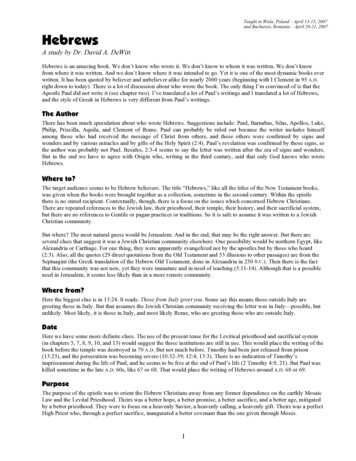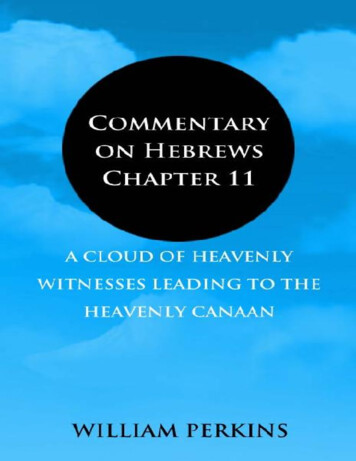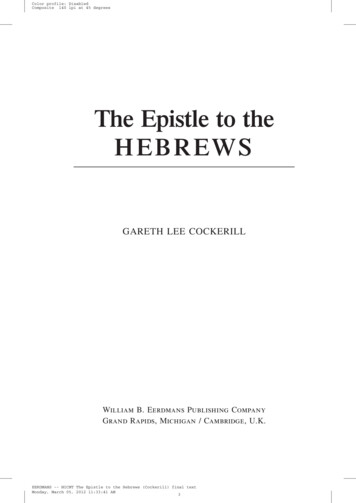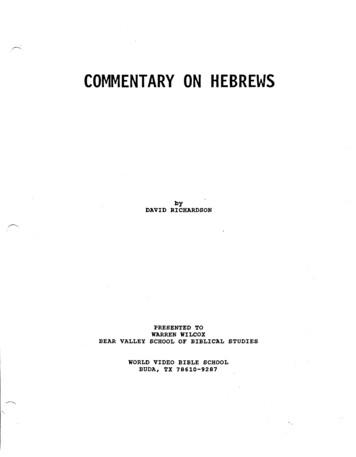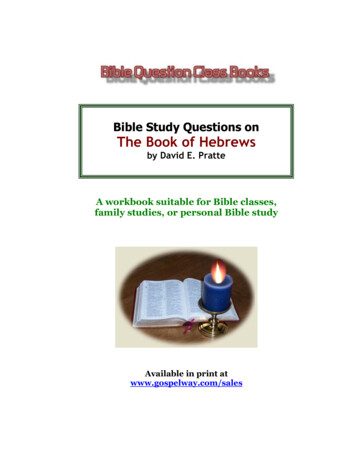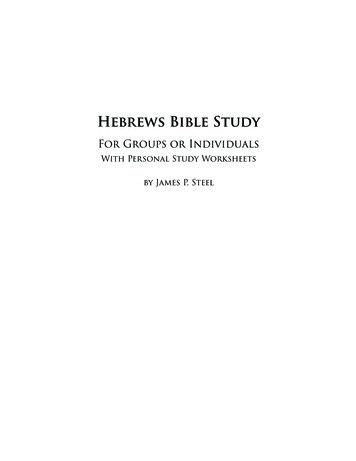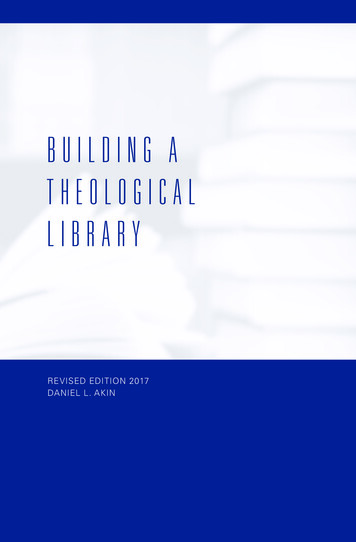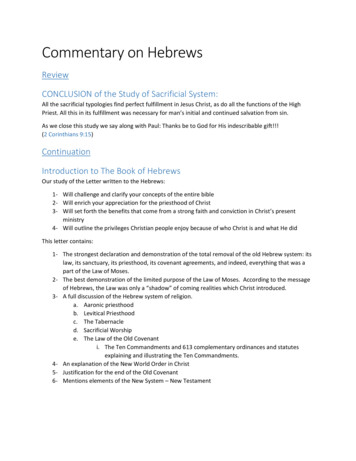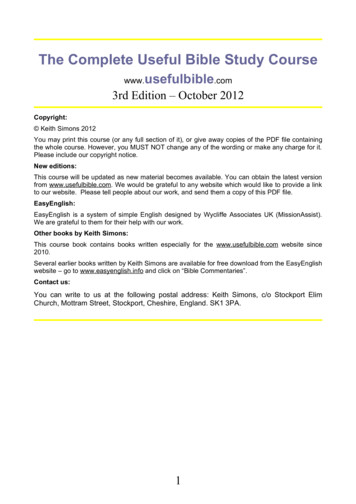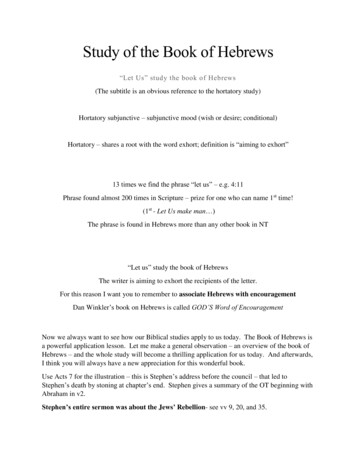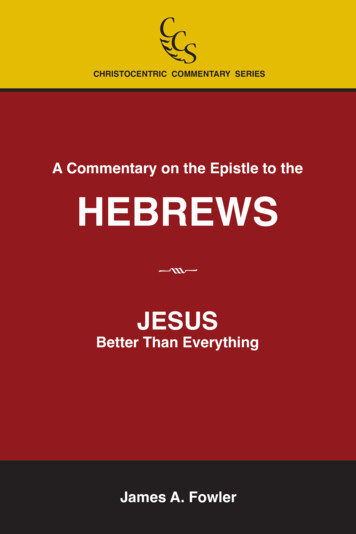
Transcription
Life Application Bible Commentary
lifeApplicationBible CommentaryHEBREWSTYNDALE HOUSEPUBLISHERS, INC.CAROL STREAM,ILLINOISBruce B. Barton, D.Min.Dave Veerman, M.Div.Linda K. TaylorSERIES EDITOR: Grant Osborne, Ph.D.EDITOR: Philip Comfort, Ph.D.
Visit Tyndale’s exciting Web site at www.tyndale.comHebrewsCopyright 1997 by The Livingstone Corporation. All rights reserved.Contributing Editors: James C. Galvin, Ed.D., and Ronald A. BeersCover photograph of bridge and path copyright by Alyn Stafford / iStockphoto. Allrights reserved.Cover photographs of woman with a laptop and man holding a pen copyright byDan Wilton / iStockphoto. All rights reserved.Cover photo of man reading copyright by Ronnie Comeau / iStockphoto. All rightsreserved.Scripture quotations marked NIV are taken from the Holy Bible, New InternationalVersion . NIV . Copyright 1973, 1978, 1984 by International Bible Society. Usedby permission of Zondervan. All rights reserved.Scripture quotations marked NKJV are taken from the New King James Version.Copyright 1979, 1980, 1982 by Thomas Nelson, Inc. Used by permission. All rightsreserved.Scripture quotations marked NRSV are taken from the New Revised StandardVersion of the Bible, copyright 1989, Division of Christian Education of the NationalCouncil of the Churches of Christ in the United States of America. Used bypermission. All rights reserved.(No citation is given for Scripture text that is exactly the same wording in all threeversions—NIV, NKJV, and NRSV.)Scripture quotations marked KJV are taken from the Holy Bible, King James Version.Scripture quotations marked NLT are taken from the Holy Bible, New LivingTranslation, copyright 1996. Used by permission of Tyndale House Publishers, Inc.,Carol Stream, Illinois 60188. All rights reserved.TYNDALE, Life Application, New Living Translation, NLT, and Tyndale’s quill logo areregistered trademarks of Tyndale House, Publishers, Inc.Library of Congress Cataloging-in-Publication DataBarton, Bruce B.Hebrews / Bruce B. Barton, Dave R. Veerman, Linda K. Taylor ; editor,Philip W. Comfort.p. cm. — (Life application Bible commentary)Includes bibliographical references and index.ISBN 978-0-8423-2856-2 (pbk. : alk. paper)1. Bible. N.T. Hebrews—Commentaries. I. Veerman, David. II. Taylor,Linda K. III. Comfort, Philip Wesley. IV. Title. V. Series.BS2775.3.B37 1997227′.87077—dc2196-53647Printed in the United States of America12 11 10 09 0814 13 12 11 10
horDateAudienceDestinationOccasion and PurposeMessageVital StatisticsOutlineHebrews 1Hebrews 2Hebrews 3Hebrews 4:1–5:10Hebrews 5:11–6:20Hebrews 7Hebrews 8Hebrews 9Hebrews 10Hebrews 11Hebrews 12Hebrews 13BibliographyIndex
FOREWORDThe Life Application Bible Commentary series provides verseby-verse explanation, background, and application for everyverse in the New Testament. In addition, it gives personal help,teaching notes, and sermon ideas that will address needs, answerquestions, and provide insight for applying the word of God to lifetoday. The content is highlighted so that particular verses andphrases are easy to find.Each volume contains three sections: introduction, commentary, and reference. The introduction includes an overview ofthe book, the book’s historical context, a time line, cultural background information, major themes, an overview map, and anexplanation about the author and audience.The commentary section includes running commentary on theBible text with reference to several modern versions, especiallythe New International Version, the New Revised StandardVersion, and the New Living Translation, accompanied by lifeapplications interspersed throughout. Additional elements includecharts, diagrams, maps, and illustrations. There are also insightfulquotes from church leaders and theologians such as John Calvin,Martin Luther, John Wesley, and A. W. Tozer. These features aredesigned to help you quickly grasp the biblical information and beprepared to communicate it to others. The reference sectionincludes an index and a bibliography.
INTRODUCTIONFaced with the choice of something good or something obviouslybad, only a foolish or misguided person would choose “bad.”Good should win every time.At the next level, however, choices become more difficult—deciding between good and better. Again in this case, the logicalchoice would seem to be “better,” but the choice is not asclear-cut as in the former situation: The differences between thetwo options may seem insignificant, the reasons for choosingwhat purports to be “better” may be unconvincing, and stayingwith the familiar “good” may feel comfortable and convenient.Thus, faced with keeping the good or moving up to better, manypeople stick with what they have, because, after all, it’s not “bad.”The next choice is even more difficult—deciding between betterand best. Again, the obvious choice should be “best” every time,but many miss what is best and settle, instead, for “better” or simply “good.” For them it is better to stay with what they know.The writer of the letter to the Hebrews had to convince the readers to settle for nothing less than God’s very best for their lives.Jews were familiar with God’s goodness and perfection. After all,they were his chosen people, and through them God had communicated his love and plan for the world. They were the recipients ofthe covenant, the law, the tabernacle, and profound religious rituals, and they had been blessed with prophets proclaiming God’smessages and priests doing God’s work. Judaism was God’s way,and it was good.But Jesus, the Christ, had come, fulfilling the law, making theperfect sacrifice, and initiating the new covenant. Christ was abetter prophet, a better priest, and a better sacrifice. In fact, hewas the ultimate, the best. Many Jews had embraced this newway, expressing faith in Christ (“Messiah”) as Savior and Lord.Yet the familiar, good Judaism continued to draw them back.Some returned to the old way, and others attempted to combinethe old with the new, forming a hybrid of Judaism and Christianity. And so they missed God’s best.Hebrews is a masterful document written to Jews who wereevaluating Jesus or who were struggling with the Christian faith.The message of Hebrews is that Jesus is better, Christianity is
HEBREWSxiisuperior, and Christ is supreme and completely sufficient forsalvation.As you read Hebrews, catch the profound message of thisimportant book. Judaism may not be calling you back, but manyother gods and belief systems clamor for attention and push forallegiance. Regardless of their claims and promises, know thatonly Jesus is the truth, and only he brings life. Jesus is the best,the only way (John 14:6). Don’t settle for anything less!AUTHORThe authorship of Hebrews has been in doubt since its publication. In fact, none of the early writers who refer to this bookmention its author. And no one since early times has been ableto identify the author.Hebrews names no one as author. This is unusual for a letter,especially if Paul had written it. (His letters usually bear his nameand personal greetings to the readers.) In fact, the only ancienttitle for this book is simply “To Hebrews,” and that may not havebeen on the original, since all of the manuscripts with that titledate after the first century A.D., the original having been writtenin about A.D. 60.The inclusion of Hebrews into the New Testament canon camefrom the Eastern church as early as A.D. 185, mainly because of thetraditional belief that Paul had written it. Clement of Alexandriadescribed his teacher’s (Pantaenus’s) explanation for why Paul didnot use his own name in this letter. Pantaenus surmised that Paulrefrained from mentioning his name out of reverence to the Lord,who himself had been their Apostle (3:1). Clement accepted thisexplanation and proposed that the original had been written in Hebrew (Aramaic) and Luke had translated it into Greek. But this isconjecture.What, then, do we know about the author for certain? Clearlythe author was an early Christian because Hebrews was used byClement of Rome in A.D. 95 (for example, 1 Clement 17; 36) andprobably by Polycarp (for example, To the Philippians 6.12) andHermas (for example, Visions 2.3.2; 3.7.2; Similitudes 9.13.7).From the content of the letter we learn several other things:nnThe author was a teacher and a second-generation Christian:“This salvation, which was first announced by the Lord, wasconfirmed to us by those who heard him” (2:3b NIV).The writer had thought long and hard about a Christianinterpretation of the Old Testament.
xiiinnnnHEBREWSThe author was probably a Greek-speaking Jew, familiar withthe Old Testament Scriptures and with the religious ideas of theJews. The author claims to share the inheritance of their sacredhistory, traditions, and institutions (1:1) and writes of them withintimate knowledge and enthusiasm.The author seems to have known the Old Testament only inthe Septuagint (ancient Greek translation of the Old Testament),which is followed even where it deviates from the Hebrew.The fact that Hebrews contains teachings that are “Pauline”along with the mention of Timothy in 13:23 seems to suggestthat the author knew Paul or associated with those who wereclose to him.The author used Greek with a purity of style and strongvocabulary, and the style is unlike any other New Testamentdocument. However, the fundamental concepts of Hebrewscorrespond fully with the writings of Paul and John.Beyond this limited profile, the letter gives few authorship clues.A number of possible authors who fit the profile have been proposed over the years:Paul. As mentioned, this has been the traditional view in manycircles. For example, the introduction to the Scofield ReferenceBible (original copyright 1909; copyright renewed in 1937 and1945) reads, “The Epistle of Paul the Apostle to the Hebrews.”Hebrews 13:23 and 2 Peter 3:15 are given as support for thisview. Some have proposed that the epistle may actually havebeen a transcribed sermon by Paul; this, it is thought, wouldaccount for the differences in style with his other letters. Paulas the author has also been the official Roman Catholic viewsince the Council of Trent (A.D. 1545–1563).The style of Hebrews, however, differs greatly from Paul’sletters. For example, it includes none of Paul’s Hebraisms, noneof his long involved sentences, none of his rapid changes inthought, and none of his usual way of introducing Old Testament quotations. Also, Hebrews contains no personal allusions(a common practice of Paul), and the author aligns with thosewho have a secondhand knowledge of the Lord (2:3), somethingthat Paul strongly denied (1 Corinthians 9:1; Galatians 1:12). Inaddition, the style of the Greek in this letter is the most elegantand pure in the New Testament, closer to Luke’s writing andunlike any of Paul’s letters.Perhaps the strongest argument against Pauline authorship isthe considerable theological difference between Hebrews andPaul’s writings. Hebrews highlights the high priesthood of Christ,
HEBREWSxiva concept totally absent from Paul’s epistles. And many of Paul’smost prominent teachings are absent in Hebrews. These include:union with Christ, justification by faith, the opposition of faithand works, and the tension between flesh and spirit.The content of Hebrews does not contradict what Paul haswritten. In fact, Hebrews and Paul’s writings hold many conceptsand teachings in common. This led Origen to conclude that muchof the contents of Hebrews was Pauline.Barnabas. Paul’s friend and companion on his first missionarytrip (see Acts 9:27; 11:22-26; 12:25; 13:1–14:28; 15:1-41),Barnabas, “Son of Encouragement,” was a Levite (Acts 4:36)and thoroughly familiar with the priestly services. Because ofthese Levite connections (Hebrews contains much Leviticalritual), Tertullian (c. A.D. 160–230) and scholars of North Africasupposed Barnabas to be the author. When introducing a quotation from Hebrews 6:1, 4-6, Tertullian wrote: “There is also anEpistle to the Hebrews under the name of Barnabas . . . and theEpistle of Barnabas is more generally received among thechurches than that apocryphal ‘Shepherd’ of adulterers” (Depudicitia 20). Despite this strong endorsement, however, thereis no other evidence or ancient support for Barnabas as author.Apollos. This charismatic preacher is mentioned from time to timein the New Testament (see Acts 18:24-28; 19:1; 1 Corinthians1:12; 3:4-6; 4:1, 6; 16:12; Titus 3:13), but we know very littleabout him. Apollos was a Jew, a native of Alexandria, well educated, and well versed in Scripture (Acts 18:24). It was also said ofApollos that “he spoke with great fervor and taught about Jesus accurately” and that “he vigorously refuted the Jews in public debate,proving from the Scriptures that Jesus was the Christ” (Acts 18:25,28 NIV). Apollos knew Timothy and had been instructed by Paul,indirectly, through Priscilla and Aquila (Acts 18:25-26).Luther proposed Apollos as the author, and many modern scholars lean in that direction because the epistle displays the kind ofallegorical interpretations that were prominent in Alexandria.Luke. Clement of Alexandria and Origen believed that Luketranslated Paul’s original writing or speaking. Parts of Hebrewsare similar to the style and content of Acts, especially Stephen’sspeech (Acts 7:1-53), but that is the only proposed connectionbetween Hebrews and Luke. This theory is quite speculative.Others. Over the years, many other writers have been proposed.Each one has a bit of support: Silvanus (Silas), a member of bothPaul’s and Peter’s circles and possibly the coauthor or secretary
VITAL STATISTICSPurpose: To present the superiority of Christ over Judaism.Author: Unknown. Paul, Luke, Barnabas, Apollos, Silas,Priscilla, and others have been suggested because the nameof the author is not given in the biblical text itself. Whoeverit was speaks of Timothy as a “brother” (13:23).To whom written: Hebrew Christians (perhapssecond-generation Christians, see 2:3) who may have beenconsidering a return to Judaism, perhaps because ofimmaturity stemming from a lack of understanding of biblicaltruths; and all believers in Christ.Date written: Probably before the destruction of the temple inJerusalem in A.D. 70, because the religious sacrifices andceremonies are referred to in the book, but no mention is madeof the temple’s destruction.Setting: These Jewish Christians were probably undergoingfierce persecution, socially and physically, both from Jewsand from Romans. Christ had not returned to establish hiskingdom, and the people needed to be reassured thatChristianity was true and that Jesus was indeed the Messiah.Key verse: “The Son is the radiance of God’s glory and the exactrepresentation of his being, sustaining all things by hispowerful word. After he had provided purification for sins, hesat down at the right hand of the Majesty in heaven” (1:3 NIV).Key people: Old Testament men and women of faith (chapter 11).Special features: Although Hebrews is called a “letter” (13:22),it has the form and the content of a sermon.OUTLINEII. THE SUPERIORITY OF CHRIST (1:1–10:18)A. Christ is greater than the angelsB. Christ is greater than MosesC. Christ is greater than the Old Testament priesthoodD. The new covenant is greater than the oldII. THE SUPERIORITY OF FAITH (10:19–13:25)
HEBREWS 1JESUS CHRIST IS GOD’S SON / 1:1-3Hebrews tells us that God spoke through many prophets at manytimes and in various ways. But all the messages, through thevariety of God’s spokespersons, simply set the stage for theunveiling of God’s Son, who is the “radiance of God’s glory”(1:3 NIV).The relationship between Christianity and Judaism became acritical issue in the early church. Hebrews 1:1–10:18 presents aseries of sections showing how Christ is superior to key aspectsof Judaism. The book of Hebrews carefully explains how Christis superior to angels (who gave the Old Testament law), Moses,and high priests. The new covenant is shown to be far superiorto the old. In chapter 1, Christ is presented as the ultimate andsuperior revelation of God. This can greatly encourage us andhelp us avoid drifting away from our faith in Christ.1:1-2 In the past God spoke to our forefathers through the prophetsat many times and in various ways, but in these last days hehas spoken to us by his Son.NIV The writer divides history intotwo segments or ages: before Christ and after Christ. He calls thetime before Christ the past. During that time, God used prophetsto reveal his message to the people. These messages are recordedin the Old Testament (because they were part of the “old covenant”). But Jesus initiated a new era (a “new covenant”) betweenGod and people. The author describes this new era as these lastdays. Translators of the Septuagint (the Greek translation of theHebrew Old Testament) used this phrase, “last days,” to describethe messianic era. The Jews of Jesus’ day believed that theMessiah would usher in God’s kingdom. They were hoping forpolitical and military power that would free them from Romanrule and bring back the days of glory under David and Solomon.They believed that the Messiah would bring peace to the world.The writer of Hebrews reported that Jesus Christ, the Messiah,initiated this new, long-awaited age. But Jesus brought spiritualpeace and a spiritual kingdom. Jesus, the Messiah, has alreadybegun his kingdom on earth in the hearts of his followers.
HEBREWS 1:1-22In the past, God spoke through the forefathers—the readers’Jewish ancestors, the patriarchs, and all the people who livedbefore Christ who had put their faith in the one true God. Theprophets include special spokespersons for God who wrote manyOld Testament books, as well as key people who did not write(such as Abraham, Isaac, and Jacob). These prophets revealedwhat they learned about God. Second Peter 1:20-21 explains thatbelievers today can trust the prophets’ words: “First of all youmust understand this, that no prophecy of scripture is a matterof one’s own interpretation, because no prophecy ever came byhuman will, but men and women moved by the Holy Spirit spokefrom God” (NRSV). God used these prophets as his mouthpieceto deliver his message.The original Jewish readers of the book would have remembered that God had used many approaches to send his messagesat many times and in various ways to people during Old Testament times. God had spoken to Isaiah in visions (Isaiah 6), toJacob in a dream (Genesis 28:10-22), and to Abraham and Mosespersonally (Genesis 18; Exodus 31:18). God had taught Jeremiahthrough object lessons (Jeremiah 13) and had taught the peoplethrough a prophet’s marriage (Hosea 1–3). Elsewhere, God hadrevealed his direction to the people through a pillar of cloud anda pillar of fire (Exodus 13:21) and had guided them in decisionmaking through the Urim and Thummim (see Exodus 28:30;Numbers 27:21).The Jews who lived during the time of Christ would not find itdifficult to believe that God was still revealing his will; however,many could not believe that God would speak by his Son. Thesame God who spoke through the forefathers had now spokenthrough Christ. Thus, there is continuity between old and newtimes. In the Old Testament, the revelation of God’s nature wasintermittent. It created an expectation that God was still goingto reveal himself more fully. The prophets spoke of the comingMessiah and his kingdom; Jesus is that Messiah and he initiatedGod’s kingdom. The Jews accepted the Old Testament, but mostrejected Jesus as the long-awaited Messiah.The recipients of this letter were Jewish Christians. Theywere well versed in Scripture and had professed faith in Christ.Through doubt, persecution, or false teaching, however, manywere in danger of giving up their Christian faith and returning toJudaism. This letter to the Hebrews shows that going back to aninferior system would be foolish. Jesus Christ not only fulfillsthe promises and prophecies of the Old Testament, but he also isbetter than everything in the Jewish system. Jesus completed andfulfilled the message that was originally brought by the prophets
3HEBREWS 1:1-2and forefathers. When we know Christ, we have all we need to besaved from our sin and to have a perfect relationship with God.Jesus is not just another prophet; he is the perfect expression ofGod. God will never need to send another divine messengerbecause Jesus faithfully revealed everything about God that weneed to know for salvation.THE ULTIMATE AUTHORITYGod revealed himself by speaking through his Son. In our day,when tolerance is the cry from every corner, any claim forreligious authority meets stubborn resistance. Hebrews claimsthat God spoke through his Son as the complete revelation ofhimself. When Jesus was revealed in his true glory at the Transfiguration (see Matthew 17:1-13), Moses and Elijah appearedwith him. Jews regarded Moses and Elijah as the two greatestprophets. Moses represented the law, and Elijah representedthe prophets. These two men had performed many miracles andwere great leaders. Yet, God’s voice from heaven said, “You areMy beloved Son, in whom I am well pleased” (Mark 1:11 NKJV).Jesus Christ should be your highest authority for faith and dailyliving. Don’t allow any religious leader or teaching to diminish thewords of Christ.God promised everything to the Son as an inheritance, andthrough the Son he made the universe and everything in it.NLTThe phrase “God promised everything to the Son as an inheritance” (literally, “heir of all things”) refers to Jesus as an heirwho will take his position as ruler of the new kingdom. Referringto Christ as the heir gives him the highest honor and position.This passage alludes to the royal Son of Psalm 2:8. In Psalm 2,the Son asks God for the nations to be given to him as an inheritance. Here Christ receives not only the nations, but all creation.Although God controls the world, he allows Satan to work. Satan,called the ruler of this world (John 12:31; 2 Corinthians 4:4;Ephesians 2:2), will continue his evil until the final day whenChrist will throw him into the lake of fire (Revelation 20:10).The poetical descriptions of the Son in 1:2 and 1:3 may havecome from an early church hymn. The hymn celebrates Christas our mediator who speaks to us from God and about God.In these two verses, Hebrews presents seven affirmations ofChrist’s deity:1. Christ as heir of all things (1:2)2. Christ as creator of the world (1:2)3. Christ as the radiance of God’s glory (1:3)4. Christ as the representation of God’s being (1:3)
HEBREWS 1:345. Christ as the sustainer of the world (1:3)6. Christ as the purifier of people’s sins (1:3)7. Christ as King over all (1:3)Jesus worked with God to create the world: through the Sonhe made the universe and everything in it (see also John 1:2;1 Corinthians 8:6; Colossians 1:15-16). Early Jewish Christiansinterpreted the role of Wisdom in Proverbs 8:22-31 as referringto Jesus’ work. Jesus was active at the beginning of time as theagent of creation, and he will act at the end of time as the heir(see Psalm 2:8; Romans 8:17; Galatians 4:7). In the end, theworld will be made perfect. Jesus will destroy all the worksof evil and will reign over the world that he created.STRESSFUL TIMESJesus was God’s agent in creating the world: “For by Him allthings were created” (Colossians 1:16 NKJV). As followers ofChrist, we may give easy assent to this truth but deny it inpractice. We may believe that Christ knows and controls thelaws of heaven (pertaining to salvation and spiritual growth),but we may act each day as though our financial, family, ormedical problems are beyond his reach. If Jesus could createthe universe, then no part of life is out of his control. Do notexclude Jesus’ wisdom and the Bible’s guidance in your complex problems of life. No expert, professor, doctor, lawyer, orfinancial adviser knows more about your ultimate security andwell-being than Jesus does. Go first to God for advice. Talk tohim in prayer and listen to him in his Word. He can sustain youin times of stress. From that perspective you can evaluate allthe other wisdom and help made available to you.1:3 The Son is the radiance of God’s glory and the exact representation of his being.NIV The writer describes Jesus (the Son)as the radiance of God’s glory. In Greek, the word “radiance”(apaugasma) can describe a reflection of what is external or ofwhat is internal. With Jesus, both are true, for his radiance perfectly reveals God’s glory. Underneath Jesus’ human appearance as a Jewish carpenter-turned-preacher was the glory ofGod. Jesus had said to one of his disciples, “Don’t you knowme, Philip, even after I have been among you such a long time?Anyone who has seen me has seen the Father. How can you say,‘Show us the Father’? Don’t you believe that I am in the Father,and that the Father is in me? The words I say to you are not justmy own. Rather, it is the Father, living in me, who is doing hiswork” (John 14:9-10 NIV). Jesus does more than merely reflectGod, he is God. Therefore, he makes God’s essence and natureclear to us (John 1:18). Furthermore, Christ radiates divine
5HEBREWS 1:3glory (2 Corinthians 4:4). He is not a copy, but the veryembodiment of God’s nature. He gives us “the light of theknowledge of the glory of God” (2 Corinthians 4:6).Not only is Jesus the radiance of God’s glory, but he is also theexact representation of his being. Jesus is God himself—the veryGod who spoke in Old Testament times. The Greek word for“being” (hypostasis) means the very substance of God; the Greekword for “exact representation” (character) was used in ancienttimes to express an imprint, an image. Thus, Jesus is the visibleexpression of God’s invisible being. We get a perfect picture ofGod when we look at Christ (John 1:18). In other words, Jesusexplains God; he came to the world and portrayed God to peopleby his words and actions. No one can know God apart fromChrist because we know God by knowing Christ. God revealshimself through Jesus (see John 1:1; 2 Corinthians 4:4; Philippians 2:6; Colossians 1:15). The prophets could only tell God’speople what they saw and heard. Jesus was God himself—hismessage was firsthand.He sustains the universe by the mighty power of hiscommand.NLT Christ not only created the universe, he alsosustains it (Colossians 1:17). He does this by preserving anddelivering the universe until he will inherit it (see commentary on1:1-2). Christ spoke the world into existence (Genesis 1–2), andhe supports the world with his omnipotent word (see 11:3).Christ does not physically hold up the world, as was said of themythical Atlas, but he guides the world toward its appointedfuture—the time when he will receive it as his inheritance (1:2).Because Christ sustains everything, nothing in creation isindependent from him. All things are held together in a coherentor logical way, sustained and upheld, prevented from dissolvinginto chaos. In him alone and by his word, we find the unifyingprinciple of all life. He is transcendent over all other powers.After he had provided purification for sins, he sat downat the right hand of the Majesty in heaven.NIV This phrasecapsulizes the author’s two main themes about Christ—hissacrifice and his exaltation. Jesus cleansed his people from theugly stain of sin. Sin destroys our ability to know or approachGod, but when God purifies us from our sins, he cleanses ourrecord. He regards us as though we had never sinned andclothes us in the righteousness of Christ himself (2 Corinthians5:21). Jesus provided purification for sins. This statementreveals the central theme of the letter: Christ’s superior sacrificefor sins. No sacrifice for sin could be greater than the sacrificeoffered by the Creator—his death on a cross. Jesus cleansed the
HEBREWS 1:36world from the domination of sin and took the penalty for ourindividual sins by dying in our place. No other penalty needs to bepaid. We can be completely clean because of what Jesus hasdone.After paying that penalty with his death on the cross, Christ satdown. This signifies that the work was complete and portrays hisexalted position. Earthly priests would stand and keep offeringsacrifices. Their work was never finished. Christ’s sacrifice wasfinal and complete. Quoting from Psalm 110:1, the writer combined two Old Testament thoughts expressing God’s greatness(the Majesty in heaven) and Christ’s position (at the right hand).To be seated at the “right hand” of a monarch was to be “secondin command”—the literal “right-hand man.” This gives a pictureof Christ’s power and authority over heaven and earth (see alsoMark 16:19; Romans 8:34). Psalm 110:1 is a crucial text and provides a guiding force in this book. Psalm 110:1 is the only placein the Bible where anyone else besides God is described asenthroned in power. This verse became a main text for the earlychurch to be used as an argument for the deity of Christ. To Jews,the description of Christ at God’s right hand would be more persuasive as a symbol of Christ’s authority and power than even theResurrection. This is why Jesus spoke these words to Caiaphasjust prior to his death and resurrection: “You will see the Son ofMan sitting at the right hand of the Mighty One and coming onthe clouds of heaven” (Matthew 26:64 NIV).FORGIVENThe book of Hebrews links God’s saving power with his creativepower. In other words, the power that brought the universe intobeing and that keeps it operating is the very power that removes(provides purification for) our sins. God created us, maintainsus, and can forgive us. No sin is too big for the Ruler of theuniverse to forgive. He can and will forgive us when we come tohim through his Son. Be honest with God; confess your sins tohim. He will forgive and cleanse (see 1 John 1:9).GOD’S SON COMPARED TO THE ANGELS / 1:4-14Angels, likened to the win
verse in the New Testament. In addition, it gives personal help, teaching notes, and sermon ideas that will address needs, answer questions, and provide insight for applying the word of God to life today. The content is highlighted so that particular verses and phrases are easy to find. E
